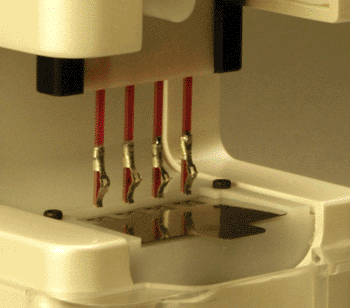Full Genetic DNA Data Available in Minutes
By LabMedica International staff writers
Posted on 20 May 2013
A new device can extract human DNA from a swab of saliva, providing full analysis and genome sequencing data within minutes.Posted on 20 May 2013
Developed by researchers at the University of Washington (UW, Seattle, WA, USA) and NanoFacture (Bellevue, WA, USA), the new device uses microscopic probes that dip into a fluid sample—saliva, sputum, or blood—and apply an electric field within the liquid that attracts particles to concentrate around the surface of the probe. Larger particles hit the tip and swerve away, but DNA-sized molecules stick to the probe and are trapped on the surface via capillary action. It takes two or three minutes to separate and purify DNA using this technology.

Image: Close-up view of the microtip probes of the device (Photo courtesy of NanoFacture).
The hand-held device can clean four separate human fluid samples at once, but the technology can be scaled up to prepare 96 samples at a time, which is standard for large-scale handling. Engineers at the University of Washington, which developed the technology, have also designed a pencil-sized device using the same probe technology that could be sent home with patients or distributed to those serving in the military overseas. Patients could swab their cheeks, collect a saliva sample, and process their DNA on the spot to send back to hospitals and labs for analysis.
“It’s very complex to extract DNA,” said lead researcher Jae-Hyun Chung, PhD, an associate professor of mechanical engineering at UW. “When you think of the current procedure, the equivalent is like collecting human hairs using a construction crane.”
Conventional methods use a centrifuge to spin and separate DNA molecules or strain them from a fluid sample with a micro-filter, but these processes take 20 to 30 minutes to complete and can require excessive toxic chemicals. The new device will give hospitals and research labs an easier way to separate DNA from human fluid samples, which will help with genome sequencing, disease diagnosis, and forensic investigations.
Related Links:
University of Washington
NanoFacture














